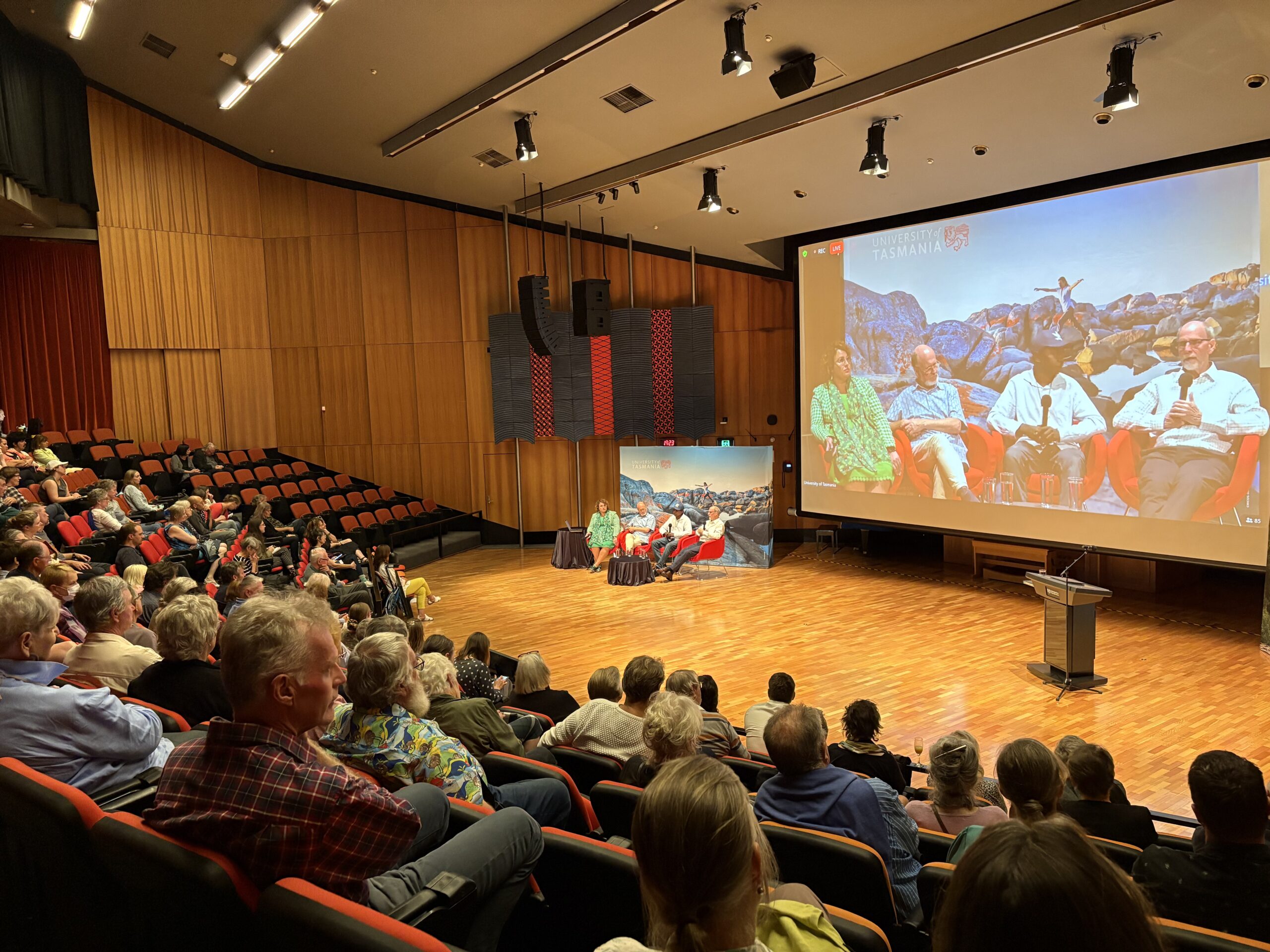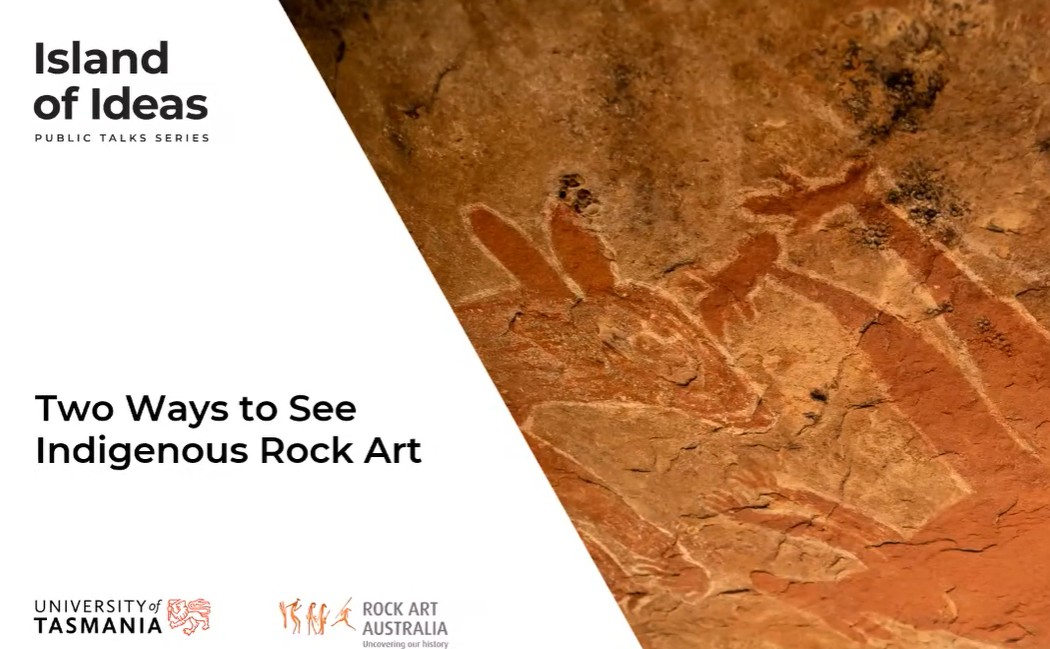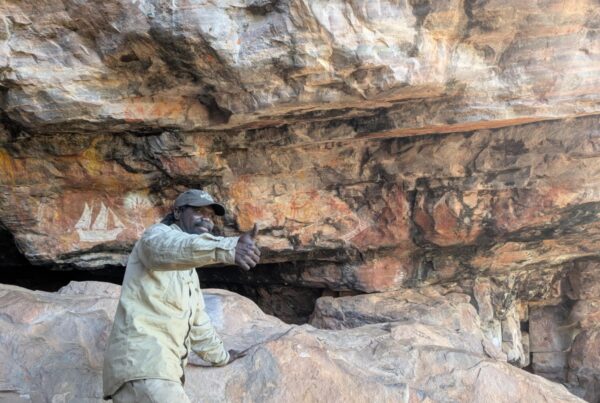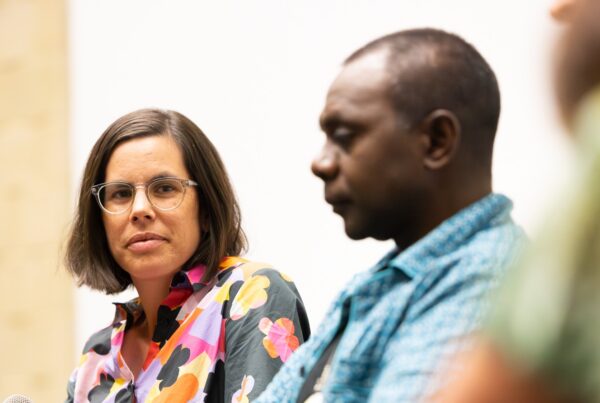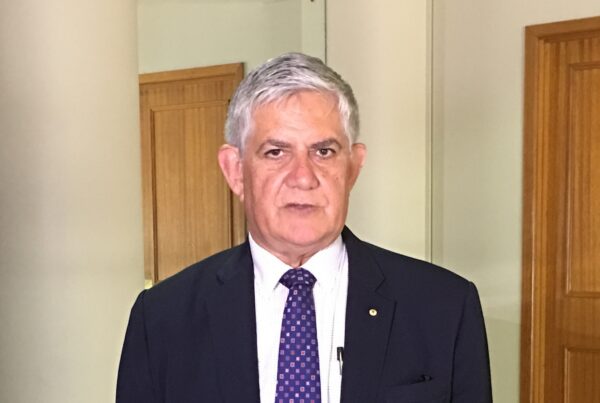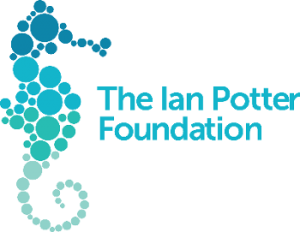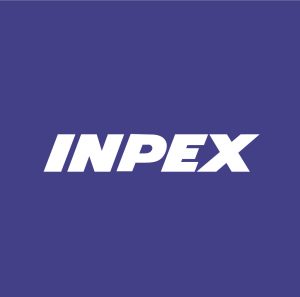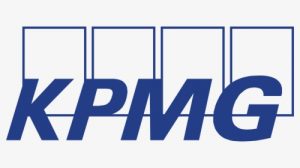Header image: Sadie Heckenberg, Greg Lehman, Ian Waina, and Andy Gleadow during the Q&A of the Two Ways to See lecture in Hobart 2025. Photo: Island of Ideas series, University of Tasmania
Looking Back
The national tour of Two Ways to See: A Rock Art Research Journey concluded in March 2025 with our final lectures in Canberra and Hobart.
Watch the Two Ways, A Rock Art Research Journey lecture
We are deeply grateful to the more than1,000 people who joined us across seven cities, both in person and online, and extend our heartfelt thanks to our generous donors, whose support made the tour possible, and to our valued partners who provided venues, volunteers, and essential local support. These partnerships are instrumental in supporting our mission to share the powerful stories and insights from our collaborative rock art research with as many people as possible, sharing facts that all Australians should know about our rich history.
A special thank you to the University of Tasmania for hosting the Hobart lecture, which was streamed live and recorded as part of the 2025 Island of Ideas Public Talks series. Please view this lecture through the below link.
Reflections: Two Ways, A Rock Art Research Journey
To celebrate the conclusion of Two Ways to See: A Rock Art Research Journey, co-presenters Ian Waina and Andy Gleadow took time to reflect on their experience. They contemplate the impact of the lecture series, what it meant to share this journey with diverse audiences across the country, and their hopes for the future of two-way research.
Ian Waina
Ian Waina’s deep involvement in the Kimberley rock art dating project has been transformative. His commitment to a two-way approach, integrating Aboriginal cultural perspectives with academic research, led to the 2023 publication of Two Ways to See: A Rock Art Research Journey. This collaborative book arose from the many questions Ian encountered during fieldwork and from his desire to better understand the deep-time history of his ancestors while sharing that learning widely. The book weaves together Traditional Owner insights, scientific research, and creative expression, including a poem by Kwini Elder Ambrose Mungala Chalarimer, to reflect Ian’s idea of “the two ways to see”: one cultural, one scientific.
As Ian reflects:
“I see the rock paintings as mine and my people’s legacy, our diary, our libraries, our cultural institutions, if you like. Working with scientists and seeing the art from both sides has been so important. That’s why I wanted to publish the book and speak on the national lecture tour with Andy. I want the world to know about the paintings, and one day, I want to learn about rock art from other countries, in other parts of the world, to see what their old ancestors had to say”.
Andy Gleadow
In the following interview, Professor Andy Gleadow reflects on a decade-long research project focused on dating the ancient rock art of the Kimberley region.
His responses highlight the importance of sustained, methodical research in addressing complex scientific challenges, such as establishing a reliable timeline for rock art. It also outlines the project’s collaborative approach with Traditional Owners and its role in building capacity among emerging researchers.
Andy concludes with reflections on the project’s broader impact and potential future directions, including the development of research infrastructure and public engagement initiatives.
RAA: You have spent a decade successfully focusing your research on investigating the age of rock art in the Kimberley, which you highlighted during the recent lecture tour. Given your experience, you likely advocate for the value of slow research. How can slow research contribute to long-term scientific advancements?
Andy: To me, ten years doesn’t really seem such a very long time considering the enormous amount that we’ve achieved over the decade. It is easy to forget that at the start of this project it was simply not possible to date most of the rock art in the Kimberley, and this is still the case in many rock art provinces around the world. In fact, Helen Green, Damien Finch and I have just returned from giving invited presentations at the 90th Annual Meeting of the Society for American Archaeology in Denver, in a session entitled “New Approaches to the Intractable Problem of Dating Rock Art”. The name of that session says it all – this is a very difficult scientific problem. Nine of the 14 presenters in that session were Australians, four of whom are directly associated with our project. To my mind, this is clear evidence of the leading position Australian researchers, and our team in particular, have established globally in addressing this very challenging research problem over the last ten years. I think we can take great pride in the fact that the sustained support for this research by RAA is having a transformative global impact in this area.
It is quite true that the approach we have taken does not favour quick results, but it has now built a body of expertise and experience, coupled with outstanding research infrastructure, that has implications far beyond the limits of this particular project. From the outset, we sought to understand everything we could about the processes operating on rock surfaces within the rock art shelters with a view to finding datable events that could be related to the timing of the art. This has succeeded beyond my wildest hopes and arrived at the point where, through the dedication of our project team, we now have over 600 dates and a calibrated time scale for the major rock art periods spanning the last 20,000 years. It took five years to do the painstaking research which enabled us to do this, with the great majority of actual dates being obtained over the last five years of the project. This has given us a foundation of understanding and a repertoire of techniques that could now be applied elsewhere, especially in similar tropical environments around the world. This is an extraordinary platform on which to build the next generation of rock art research, and not just in dating.
RAA: The Rock Art Dating Project almost became like an academy for the next generation, not just for emerging scientists, but also for younger members of Indigenous communities, and Traditional Owners you collaborated with. Was it rewarding to see the next generation engaging with the work, both by embracing the findings and contributing to the research itself?
Andy: I have said on several occasions during our lecture tour over the past year that the people involved, both researchers and our indigenous partners, have been just as important an ‘output’ from this work as the research results themselves. The mutual understanding that has emerged of different ways to approach rock art is captured well in the title of Ian Waina’s book, ‘Two Ways to See’, also used for our lecture series. This encompasses very well the sense of mutual respect and appreciation that has emerged between the traditional and scientific viewpoints embraced by the project participants. An enduring legacy of this amazing project is represented by the emerging leaders who are now framing new directions in rock art research to further develop our understanding of this priceless heritage. This work will go on in various forms for the benefit of Traditional Owners and for the enrichment of the wider public. For me, it has been exceptionally rewarding to watch the large group of people involved in the project, from many different backgrounds, all coming together to collaborate on something of great importance to Australia’s sense of its own deep history and our place in the world.
RAA: You’ve often said in your lectures that working on this project has been the privilege of a lifetime. What impact has this project had on you, and what has been the most rewarding aspect for you?
Andy: It has indeed been a very great privilege for me to initially put this project together and then to work with such an amazing group of people who have shown with such a strong sense of common purpose amongst both scientists and Traditional Owners. I think that all of us involved in this project have had a sense of being part of something much bigger than ourselves, something that is really important to the nation. To have first-hand experience of working together in the Kimberley landscape with the Traditional Owners and visiting so many wonderful rock art sites with them is a privilege that few have known and all of us have become aware of how special this is.
As someone who is now in the final stages of a long career in research, the single most important thing for me has been getting to know and becoming close friends with people from one of the remotest indigenous communities in Australia. I think all of the researchers will agree that the degree to which we have been embraced by the Traditional Owners is one of the least expected but most unforgettable highlights of being part of this project. I think we all feel sad that the formal project has now come to an end, but there is also a sense that the deep relationships formed and the work we have started will endure long into the future.
RAA: Are you hopeful that research and public awareness campaigns of this nature will lead to a collective desire to ensure the preservation and interpretation of rock art as Australia’s important cultural heritage?
Andy: That has been my great hope since the outset of this project. I very much see our role as one of translating the incredible richness of the rock art in the Kimberley, and that of Australia more broadly, into terms that non-indigenous Australians can understand and embrace as a really key part of our national heritage. There is something about the visual representation of the natural environment, the people, stories and culture from so long ago that is deeply engaging and this is something I would love all Australians to learn about and take great pride in preserving for future generations.
RAA: What role do collaborations between scientists and Traditional Owners play in ensuring the preservation and interpretation of rock art?
Andy: One of the important outcomes of the way we have undertaken the dating research is that, in addition to the dating results obtained, we have learned so much about the natural processes operating in the landscape and the rock shelters which ultimately control the survival of the art. This has given us a foundation upon which to build new scientifically based approaches to rock art conservation and management. Dating is of course extremely important in this as it enables us to understand how fast the natural processes that degrade and ultimately destroy the rock art are operating. For example, we have already identified some important rock art sites that are at imminent risk of structural collapse due to the operation of perfectly natural processes. The responsibility for future conservation and management of rock art at the local level, of course, rests with the Traditional Owners, but together I believe the research can help by putting everything we have learned to work towards this new objective.
RAA: If granted unlimited resources, what ‘dream’ project would you pursue to transform a global understanding of Australia’s deep history?
Andy: Over the lifetime of our project, we have visited hundreds of amazing rock art sites across the northern Kimberley region and the impact of the richness of this province is quite breathtaking. Obviously, it is not possible for everyone to see as much of this as we have been privileged to do, but I would love to find a way that we could bring something of the wonder we have experienced in a form that all Australians, and indeed visitors from all over the world, could appreciate. I would love to see such a level of interest develop in this heritage that it could become the basis of a sustainable tourist industry that would greatly benefit the local indigenous communities.
In the last five years I have been able to visit the amazing museums and site replicas that have been set up for visitors to the Chauvet and Lascaux rock art sites in France. The most recent exhibits are extraordinarily well done and have been built at a combined cost of about A$200 million, reflecting the deep national pride that is felt by the people of France for these globally important sites. But they also attract over 700,000 visitors to the region each year, the basis of a large and prosperous tourism industry in that region. I believe that something similar could also be developed here for our no less globally significant sites.
If I had access to unlimited resources, I would love to see such a museum, perhaps combined with a rock art research centre, set up here in Australia, preferably in the Kimberley, to showcase replicas of some of our most remarkable rock art sites. To be effective, this would need to be done to a similarly high standard as in France, and perhaps drawing on their experience, so that the reproductions are essentially indistinguishable from the originals. This is ultimately something that would require substantial government resources and the involvement of many indigenous groups, but I believe that this is a vision that RAA could play an important role in promoting and an objective we could help guide towards fruition.
Purchase a copy of Two Ways to See: A rock Art Research Journey
The book shares how Traditional Owner, Ian Waina and the Kwini people, archaeologists and environmental scientists worked together, sharing traditional knowledge and scientific methods, to find out how long ago the Old People created the rock art on Balanggarra Country, East Kimberley.
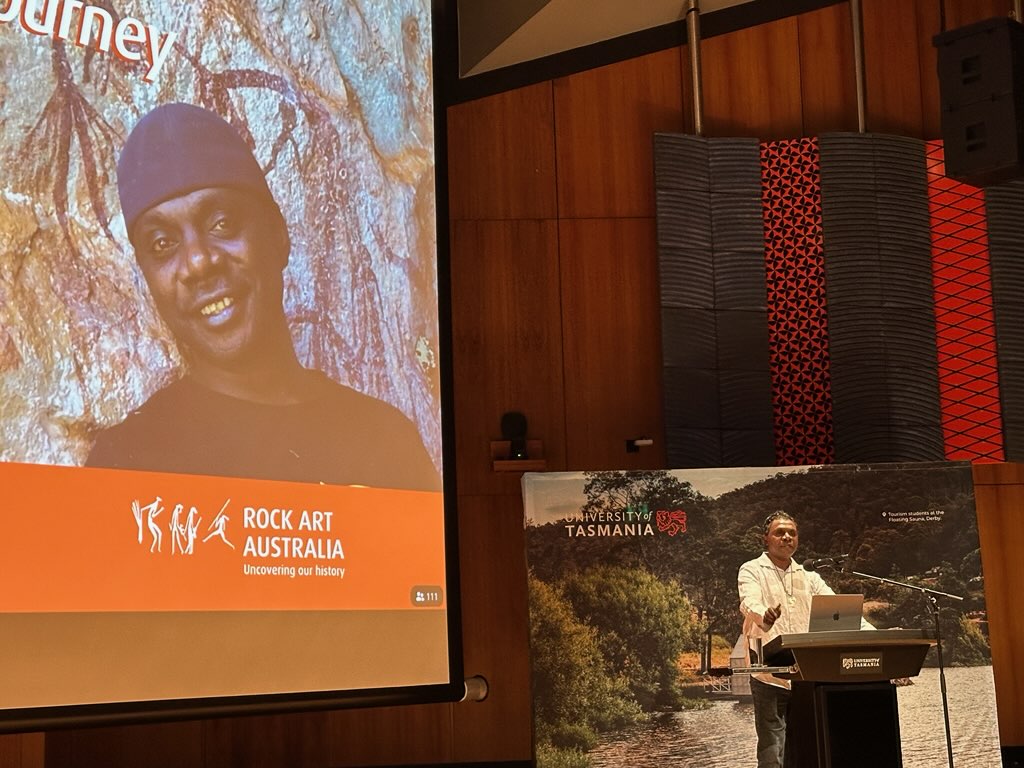
The Rock Art Dating Project
The Two Ways lecture provided insights into the findings and scientific discoveries of the magnificent rock art galleries of the Kimberley of the groundbreaking Rock Art Dating Project.
The Rock Art Dating Project applied new knowledge of complex processes on sandstone surfaces across the north Kimberley and used an innovative combination of four scientific dating methods developed in earlier work. All work was conducted in partnership with the Balanggarra Aboriginal Corporation. Click the button below to learn more about the project.

